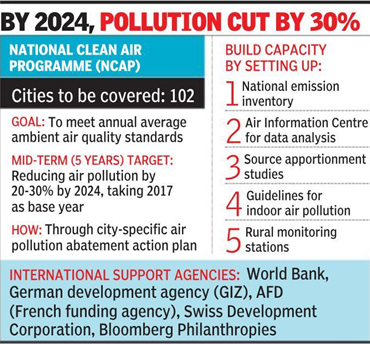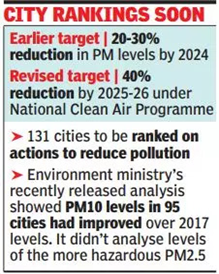In News:
- The Central government has revised the target for reducing air pollution (particulate matter (PM) concentrations) in cities from 20-30% by 2024 to 40% by 2025-26.
- The revised target may prompt the respective states to increase their ambition through city-based action plans under the National Clean Air Programme (NCAP).
What’s in today’s article:
About National Clean Air Programme (NCAP):

- NCAP was launched in 2019 by the Ministry of Environment Forest and Climate Change (MoEFCC), Government of India.
- It is India's flagship program that outlines a long-term, time-bound, national level strategy to tackle the air pollution problem across the country in a comprehensive manner.
- It aims to achieve a 20% to 30% reduction in PM (PM10 - coarse PM of diameter 10 micrometres or less and PM2.5 -fine particulate matter of diameter 2.5 micrometres or less) concentrations by 2024, using 2017 as the baseline year for comparison.
- The country’s current annual safe limits for PM2.5 and PM10 are 40 ug/m3 (micrograms/per cubic metre) and 60 ug/m3.
- In accordance with the Air (Prevention and Control of Pollution) Act, 1981, the Central Pollution Control Board (CPCB) will execute this nationwide program.
- Under NCAP, 131 non-attainment cities (earlier 102, to which more added later) have been identified across the country, as they did not meet the national ambient air quality standards (NAAQS) for the 2011-15 under the National Air Quality Monitoring Program(NAQMP)
- Delhi, Varanasi, Bhopal, Kolkata, Noida, Muzaffarpur, Mumbai, etc., are among them.
- City-specific action plans have been developed, which include measures to strengthen the monitoring network, reduce vehicular or industrial emissions, raise public awareness, etc.
- The implementation of city-specific action plans is regularly monitored by Central and State Committees, namely the Steering Committee, Monitoring Committee and Implementation Committee.
- State Pollution Control Boards monitor city air quality and publish their findings on a regular basis.
- For effective monitoring, some Smart Cities have established Integrated Command and Control Centres (ICCCs) that are also linked to Air Quality Monitors (AQMs).
- As part of the program, the Centre intends to expand India's air quality monitoring network.
- According to an estimate, at least 4,000 monitors are required across the country, in addition to the existing 101 real-time AQMs.
News Summary:

- Based on the performance of 95 cities that showed improvement in air quality in 2021-22 compared to 2017 levels, the central government has revised the targets recently.
- According to a recent MoEFCC analysis of cities under NCAP, 20 cities (including Chennai, Madurai, Nashik, and Chittur) have even met the National Ambient Air Quality Standards (NAAQS), which set an acceptable annual average limit of PM10 at 60 ug/m3.
- The analysis, however, was silent on the more dangerous PM2.5 because it is not monitored in all NCAP cities. The annual average prescribed standard for PM2.5 under NAAQS is 40 ug/m3.
- The new target was conveyed to states during the recently held national conference of Environment Ministers in Ekta Nagar, Gujarat.
- During the national conference, the MoEFCC decided to rank these 131 cities annually based on different actions taken for improving air quality, like solid waste management, road dust management, management of construction and demolition waste, control of vehicular emissions and industrial pollution.
- The idea behind the revised target is to ultimately achieve acceptable limits of both PM10 and PM2.5 concentrations.
- A 40% reduction in PM concentrations over 2017 levels would still result in unacceptable air quality in Delhi and other NCR cities, Mumbai, Kolkata, Lucknow, and Kanpur.
- However, many cities are expected to achieve much higher reductions, such as Varanasi, which recorded the highest 53% reduction in PM10 levels in 2021-22 (over 2017 levels).









